
THE HEART OF THE CITY
GENERAL HISTORY

 The first documented visitors to the
Hamilton area were Étienne Brűlé in 1616 and some years later, in 1669, LaSalle. These
pioneering explorers were later followed by settlers, travelling merchants, and other
pioneers. In the beginning of the nineteenth century, Loyalists fleeing from the American
Revolution drifted into the area and remained. In 1791, the number of inhabitants settled
in the area was few. There were only 31 families registered as being settled in Hamilton.
By 1823, the population had exploded to over 1,000 people.
The first documented visitors to the
Hamilton area were Étienne Brűlé in 1616 and some years later, in 1669, LaSalle. These
pioneering explorers were later followed by settlers, travelling merchants, and other
pioneers. In the beginning of the nineteenth century, Loyalists fleeing from the American
Revolution drifted into the area and remained. In 1791, the number of inhabitants settled
in the area was few. There were only 31 families registered as being settled in Hamilton.
By 1823, the population had exploded to over 1,000 people.
The City and surrounding land has greatly changed its topographical appearance since
the early days. It was not always characterized by the common contemporary sights of
asphalt roads, cement sidewalks, brick and concrete buildings, shopping centres, hoards of
automobiles and pedestrians, and enormous industries. John Ryckman, born in Barton
township, described the area in 1803, as he remembered it:
"The city in 1803 was all forest. The shores of the bay were difficult to reach
or see because they were hidden by thick, almost impenetrable mass of trees and
undergrowth . . . Bears ate pigs, so settlers warred on bears. Wolves gobbled sheep and
geese, so they hunted and trapped wolves. They also held organized raids on rattlesnakes
on the mountainside. There was plenty of game. Many a time I have seen a deer jump the
fence into the back yard, and there were millions of pigeons, which we clubbed as they
flew low." (Houghton, Margaret E.)
The contrast between then and now is only too evident. Up until 1818, both John and King
Streets, today busy retail thoroughfares, were simple unmarked slashings in the brush.
Over time, this area became recognized as the centre of the village, and it was proposed
that a square mark the spot.
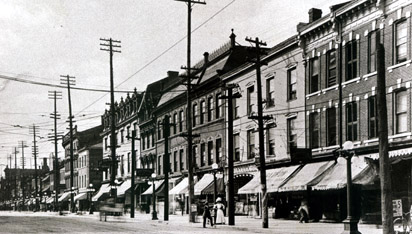 One
of the major attractions drawing people to the area was the lovely harbour, which was
twice the size it is now. The waterbed was of white sand, which could be seen through the
clear water. There was one main problem associated with the bay – many large inlets
went far up into what is now the heart of the city, and in the spring, the area was
transformed into one great bog, cutting the north half of the town off from the southern
half. Malaria ran rampant in the marsh that was then the north end of the city.
One
of the major attractions drawing people to the area was the lovely harbour, which was
twice the size it is now. The waterbed was of white sand, which could be seen through the
clear water. There was one main problem associated with the bay – many large inlets
went far up into what is now the heart of the city, and in the spring, the area was
transformed into one great bog, cutting the north half of the town off from the southern
half. Malaria ran rampant in the marsh that was then the north end of the city.
There was one individual whose personal contribution and devotion to the area that would become the city, was significant. It was just after the outbreak of the War of 1812 when George Hamilton, the man after whom the city would be named, accompanied by his wife and infant son, moved from Queenston to the Head-of-the-Lake. Only a few years later, he laid out a town site on his property and named the streets after members of his family (James, John, Catharine, Hannah, Maria and Augusta). James Street was the focus of the settlement. At that time, the streets were narrow and often discontinuous across the two main streets. King Street, even in the early days of exploration, had been a route of importance. The pioneer merchants first decided upon this thoroughfare as the coming centre of their community’s trade and commerce. It was in 1813 that King Street laid out and named in honour of the King of England. Even as far back as 1791, this street promised to be prominent. In the early life of the community, John Street was the commercial district while James Street was the Lake Road (south to King) from the Steamboat Wharf.
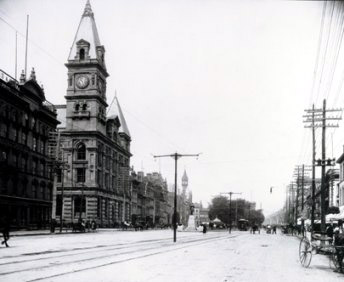 George Hamilton’s original objective
was to create a town centred around a courthouse square. Hamilton owned a large piece of
land with a rather strange shape. He planned to combine this piece of land with another
held by Nathaniel Hughson, to form a town square. Hughson initially promising his piece of
land, in the end reneged on the deal. For the longest time thereafter, Hamilton’s
triangular "gore" of land remained undeveloped and was used by nearby
storeowners as a refuse heap. This piece of land, over time would become one of the
dominant features decorating the downtown core. It would later be described as "the
green oasis in desert of asphalt".
George Hamilton’s original objective
was to create a town centred around a courthouse square. Hamilton owned a large piece of
land with a rather strange shape. He planned to combine this piece of land with another
held by Nathaniel Hughson, to form a town square. Hughson initially promising his piece of
land, in the end reneged on the deal. For the longest time thereafter, Hamilton’s
triangular "gore" of land remained undeveloped and was used by nearby
storeowners as a refuse heap. This piece of land, over time would become one of the
dominant features decorating the downtown core. It would later be described as "the
green oasis in desert of asphalt".
On March 22, 1816, the Legislature of Upper Canada passed an Act, which served to erect and form a new District, which was to be called the District of the Gore. A court house was also erected as a symbol of law and order. The newly recognized district flourished. In the 1820s and 1830s a rash of hotels sprang up and one record states that there were more hotels and taverns than houses in the community. In 1826 the population of Barton Township was 1,195 people. By 1833, an assessor’s census of Hamilton alone showed a population of about 1,400. Two years later the population had jumped to 2,600 people. A map of Hamilton in 1830 showed the that region encompassed a surveyed area of 100 acres. Only six years later, the area was assessed at having 800 acres. The expansion and population increase was due, in part, to the building of the Burlington Bay canal.
The opening of the canal, which brought employment, business, and people to the area, also brought disaster. An epidemic of cholera struck in 1832. On June 20th of that year, many fearful citizens met at the courthouse with the intention of eliminating the plague that was killing their families. They resolved to remove piles of garbage, ashes and rubbish from the streets, alleys and yards, to scrub dwellings and public places, and to clean out and disinfect cesspools, privies and all other germ breeding sources. The outbreak of cholera was believed to have been bred in the holds of immigrant ships that were continually arriving in Hamilton. One paper estimated that "One hundred immigrants a week land in Hamilton", each potentially carrying the strange and unfamiliar plague with them. Many people living in the area died from the disease because it had never been seen in the area, and effective methods of treatment were unknown. It was only with the approach of the colder winter weather, that the plague died out, taking with it the lives of hundreds.
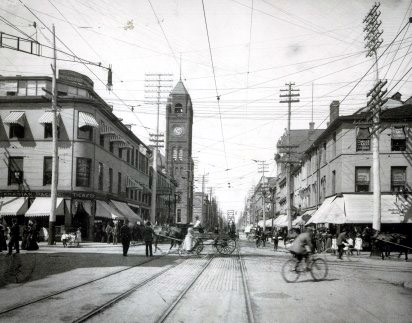 For the Head-of-the-Lake region, the advent of the 1830s seemed to
bring an era of unparalleled prosperity. There was an easily navigable and protected
harbor, accessible through the new canal. The town became an important location through
which to pass en route to the expanding west. Emigrants were coming in ever-increasing
numbers, and many, seeing the potential of the area, decided to settle, rather than
continue on. These travelling people brought new industry and prospering commercial
interests. Real estate sales flourished and construction boomed. There were numerous and
varied reasons for settling in this land of plenty. As one settler wrote:
For the Head-of-the-Lake region, the advent of the 1830s seemed to
bring an era of unparalleled prosperity. There was an easily navigable and protected
harbor, accessible through the new canal. The town became an important location through
which to pass en route to the expanding west. Emigrants were coming in ever-increasing
numbers, and many, seeing the potential of the area, decided to settle, rather than
continue on. These travelling people brought new industry and prospering commercial
interests. Real estate sales flourished and construction boomed. There were numerous and
varied reasons for settling in this land of plenty. As one settler wrote:
"We are very well provided for, with regard to a situation. We have a very good
house and our fire round us, and George has wages, 100 dollars a year, and all his keep;
which is much better than I should have found in England. My master is an Englishman, and
a very good master, for he makes everything to my satisfaction, and I am very happy to
think the Lord has provided me so well, and I have to inform you that I never desire to
come to England anymore, for we found it a troublesome journey to that happy spot where we
are now situated. I have to inform you that we need not go to bed a-cold nights for want
of something to keep us warm, for we can get liquors very cheap, good rum at 5d. per pint,
whiskey 7 ˝ d. per quarts, &c." (Houghton, Margaret E.)
In the 1830s, accommodations for what was a predominantly young transient male population were rudimentary and scarce. Taverns and shanties were thrown up hastily. A small number of men even lived at the place of their employment. Between 1830 and 1838, the number of assessed shops and warehouses quadrupled in relation to trade and population increases. Some of these were multi-purpose establishments, such as Joseph Case’s "Grocery and Beer Shop".
On Friday November 16, 1832, a fire broke out in a tavern in the heart of the town. In less than an hour, the flames had spread to five other buildings, including the post office and within three hours everything lay in ruins. The loss was serious.
The Legislature passed another Act, which defined the limits of the Town of Hamilton, in the District of the Gore, on January 8, 1833. A police force and public market were established not long after. The first sidewalk was laid on James Street from the corner of Main Street to Gore Street, where the post office was located, in 1833. "The Garland", a local newspaper devoted entirely to literature, published a synopsis of Hamilton, specifying that it contained "about one hundred and twenty dwelling houses and upwards of one thousand inhabitants". It then went on to list four public buildings, seven taverns, sixteen stores, two watchmakers, two saddlers, four merchant tailors, four cabinet makers, four boot and shoe makers, two bakers, four newspapers, one druggist, one tin and sheet manufactory, one hatter and three millineries. The following year, the town reported a balanced budget. This financial stability, which would lead into the decade to follow, was in part responsible for the incorporation of the Town of Hamilton as the City of Hamilton. The population was continually increasing and the industrial and commercial sectors were growing. The region’s boundaries were expanding and crime rates were low. It was also in this year that Hamiltonians were assessed for their first municipal taxes.
 In 1834, under the direction of Allan
MacNab, Hamilton took one of the first steps toward railway development. They obtained a
charter to build the London and Gore railway from the Burlington Bay to London, with an
extension to Windsor and Sarnia. The community below the mountain was approaching
incorporation as a city. A town bell was added, as was a corporation seal and a Mechanics'
Institute. In May of that same year, work began on Hamilton’s first market place. A
hospital was built and not long afterwards, a fire engine was purchased.
In 1834, under the direction of Allan
MacNab, Hamilton took one of the first steps toward railway development. They obtained a
charter to build the London and Gore railway from the Burlington Bay to London, with an
extension to Windsor and Sarnia. The community below the mountain was approaching
incorporation as a city. A town bell was added, as was a corporation seal and a Mechanics'
Institute. In May of that same year, work began on Hamilton’s first market place. A
hospital was built and not long afterwards, a fire engine was purchased.
It was certain that the future prosperity of this growing town was secured by the promise of its youth. The Gore District Public school, located on James Street North, earned province-wide recognition. The name was later changed to the Gore District Grammar School. There were also many private schools where students could be taught Reading, Writing, Grammar, Composition, Logic, Arithmetic, Geography, History, Astronomy, Natural Philosophy, French, and Needlework. It was evident that educating the young was a primary concern for the population of Hamilton.
The latter part of the 1830s was a period of industrial and commercial growth for the city. On April 30, 1836, the Bank of Upper Canada closed its Hamilton office and the
Gore Bank opened just a few days later. A new stone building was eventually erected on the corner of King and Hughson Streets. In March of the following year, the board of Police was determined to erect a second market in a more central location, more accessible for both farmers and townsfolk. There were two offers of free land. The first offer was a site on King William and Hughson Streets from the Messrs. Stinson. The second offer came from Andrew Miller and this site was located on the corner of James and York Streets. Within a month, the latter location had been selected, a deed was received and notices published calling for tenders and plans for a market building of brick or stone with a hall above the market place and cellars beneath. A new market had been established.Throughout the 1840s there was some confusion as to who exactly owned the triangle of land that George Hamilton wanted to form into a public square. After great debate, this land was deemed as public land (the City had acquired the deed) and Hamilton’s business district formed around it. As the city scrambled to prepare for the first Royal visit, many came to realize that the Gore was in desperate need of both improvement and beautification. When Council refused to take quick action on a proposal by the water commissioner to construct a fountain,
Isaac Buchanan and several other prominent citizens proposed a joint venture: if the city would put up $1,200 to improve the Gore, they would match it. Archibald Kerr presented a fountain to the city, which was placed in the park.Once the park had been established, the commercial district formed around it. Retail
dominated the north side while wholesale flourished on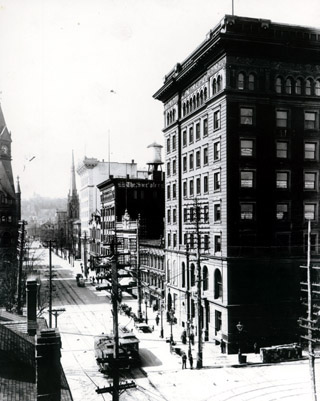 the south side. Banks were located near the wholesalers,
lawyers had offices on Main Street close to the Court House, and artisan shops and
manufacturing establishments dominated the outer central area. Hotels and boarding houses
were located between the outer central area and the downtown.
the south side. Banks were located near the wholesalers,
lawyers had offices on Main Street close to the Court House, and artisan shops and
manufacturing establishments dominated the outer central area. Hotels and boarding houses
were located between the outer central area and the downtown.
The Act of Incorporation to make Hamilton a city, was passed in 1846, although it did not take effect until the January 1847 election. At the time, the census reported Hamilton as having a population of 6,832.
On January 15, Colin Campbell Ferrie was elected the first Mayor of the City of Hamilton. On March 15, City Council held the first council meeting in the Market Hall, which from this time forward would be known as City Hall.
The Spectator, Hamilton’s oldest and leading newspaper, was founded on James Street North, facing the market in 1846. The first edition of the paper was printed in a small print shop above Dalleys Drug store. The first issue dealt with the defects and annoyances of the postal system. The conservative Spectator was set up in competition with the extremist, Tory Western Mercury and the rather liberal Hamilton Free Press.
Over time, the
Spectator beat out all competitors and today dominates the Hamilton journalism scene.In August 1847, Hugh Cossart Baker Sr. (manager of the first branch of the Bank of Montreal in Hamilton) founded
the Canada Life Assurance Company. Baker was the Manager, President and Actuary of the company. Its first location was in rented quarters at the Mechanic's Institute, on James Street North. The company later moved to the Canada Life Building on James Street North, where the present day Pigott building is located.In 1848, the City was again hit with an epidemic. This time, small pox. The outbreak led council to procure a house for patients afflicted with the disease. This resulted in the first mass public health program of free clinic vaccinations. Operating in pairs, ten doctors conducted afternoon clinics at City Hall on Wednesday and Saturday for a period of three weeks in February. A small building on Catharine Street was approved as a location to treat patients. It was crowded with only four patients. This gave rise to the creation of a new hospital, which was erected on two acres of city property lying just below the mountain, at the head of Cherry Street (now Ferguson Avenue). This new institution was named The House Of Industry. In November 1853, the first train on the 43-mile leg of the Great Western line, from Suspension Bridge to Hamilton, arrived.
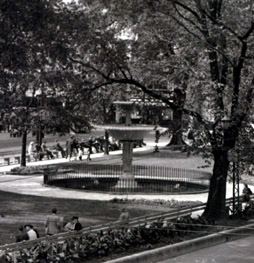 It was in the spring 1860 that the Gore beautification project, which called
for the construction and installation of a
It was in the spring 1860 that the Gore beautification project, which called
for the construction and installation of a
In 1862, the city suffered bankruptcy and houses began to empty as tenants fled. The lights lining the streets were shut off in an attempt to save money. The water in the fountain in Gore Park was also turned off to save the expense of pumping. It was only when the city again reached financial stability that the lights were turned back on, however they only remained lit until midnight. Finances fluctuated over the years but bankruptcy proved disastrous.
Industry in Hamilton included the
Sanford McInnes & Company wholesale clothing manufacturers, Joseph Flint who operated the first saw factory in Canada, Mr. Beech, who hand-made the first Canadian files, Young & Brother, who produced the first burners for coal-oil lamps in Canada, and Dennis Moore & Company, who were engaged in the business of iron founders and the manufacturing of stoves, tinware, tools and machines.In 1866, the Board of Health resumed activity. A citywide clean-up campaign was staged which included public education and participation. Roads and sidewalks were repaired and extended, sewers and water mains were further developed, and industrial and domestic connections increased in number. Real estate values also improved. A depression from 1873 to 1878 slowed the local economic growth.
In 1868, the corporation of the City of Hamilton withdrew its account from the
Gore Bank, which had been one of the most important financial institutions of the city. At one time the Gore Bank was the financial backbone of many Hamilton industries. In 1870, after two reductions of capital stock, the bank consolidated its shares. It then amalgamated with the Canadian Bank of Commerce, which assumed headquarters in the building.By the 1870s, the face of the city was changing. The wooden canopies that once stood before the shops were vanishing in favour of canvas awnings. Telephone poles were also put up along the streets.
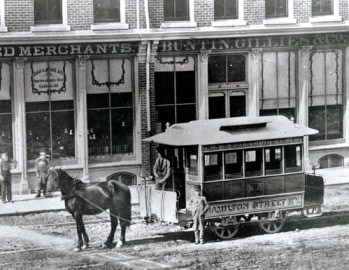 In 1873, Lyman Moore, druggist, and his brother-in-law, Dr. Lewis
Springer, with J.B and T.B.Griffith, substantial shareholders, obtained a charter to
operate a public transportation system with two miles of track to be in operation by
January 1, 1875. Cars were to be drawn by horses or mules at not more than seven miles an
hour with adult fares priced at five cents and children’s fares priced at three
cents. On May11, 1874, the first horse-drawn car left the barns at MacNab and Stuart
Streets, travelled south on James to King Street and turned east to Wellington Street. In
1881, a trackless grooved turntable was installed at the busy King and James Streets to
turn the card driven on it. Three years later, cedar block paving was laid throughout the
downtown core.
In 1873, Lyman Moore, druggist, and his brother-in-law, Dr. Lewis
Springer, with J.B and T.B.Griffith, substantial shareholders, obtained a charter to
operate a public transportation system with two miles of track to be in operation by
January 1, 1875. Cars were to be drawn by horses or mules at not more than seven miles an
hour with adult fares priced at five cents and children’s fares priced at three
cents. On May11, 1874, the first horse-drawn car left the barns at MacNab and Stuart
Streets, travelled south on James to King Street and turned east to Wellington Street. In
1881, a trackless grooved turntable was installed at the busy King and James Streets to
turn the card driven on it. Three years later, cedar block paving was laid throughout the
downtown core.
The most spectacular of all fires in Hamilton was the blaze that destroyed the five-storey
D. McInnes & Company merchant stores on the southwest corner of King and John Streets in 1879. The McInnes fire marked the beginning of Hamilton’s modern fire department with the first Chief of the Fire Brigade, James McCabe.In April 1873, council agreed that "the Park on King Street be formerly laid out and planted with flowers and shrubs, and the fence and the fountain newly painted." It was not until June 1883 that the park officially and formally opened to the public. The gates were, from that day forward, unfastened each morning at seven and locked at eight in the evening. The newly accessible park became an increasingly popular spot for citizens to meet.
In the 1890s, Hamilton became an industrial hub in south-central Ontario. The early concentration of iron and steel manufacturing here was not accidental. Hamilton was in a very advantageous location. Nearby coal supplies in the United States, and the plentiful supply of iron ore in Northern Ontario, coupled with Hamilton’s superb natural harbor on the Great Lakes, made it the ideal location for new industry. An American visitor to Hamilton in 1889, who was greatly impressed with the city’s industrial potential wrote: "Look down upon it from the mountain top and it is one vast field of tall chimneys and the smoke from its hundreds of factories hangs over the city like a beautiful web." Hamilton would become one of the most prominent industrial sectors of the region.
The first electric trolley cars of the Hamilton Street Railway (H.S.R.) were put into service on June 29, 1892. The trolleys initially shared major routes with some of the horse-drawn carriages, which had been in use since 1874. By July 1, 1892, the H.S.R.’s new cars carried more than 20,000 passengers on the only two routes running along King Street East and James Street North. These electric cars would continue to be used on Hamilton’s streets until April 6, 1951.
In May 1898, 64 of Hamilton’s most prominent businessmen, some with shops facing Gore Park, presented a petition to the City council requesting that the park be extended as far east as John Street. Council agreed and arrangements were made to sod the area and plant flowers. At a council meeting, Alderman Frederick Watkins expressed the popular view that the extension of the park was key to making "the heart of the city a thing of beauty and a joy forever". The next addition to the park was a flagpole, suggested by the Canadian Club in 1900. The offer was quickly accepted, and a 150-foot flagpole, in the style of an oil derrick, "made of steel angles and pipes thoroughly galvanized and guaranteed", was ordered at the cost of $165. It was unveiled on Victoria Day that year. Two years later, a group of prominent citizens calling themselves the "Queen Victoria Memorial Committee", asked for permission to erect a statue of Queen Victoria, to be located in the park. Permission was given on the condition that the statue would not interfere with the symmetry of the park, and that the committee would raise the required funds themselves.
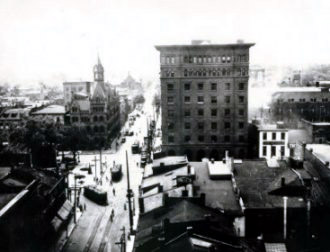 The Queen Victoria Statue, located in the Western end of Gore Park, was erected
in 1908 to honour the Queen after whom it was named. A great unveiling ceremony was held
and the Governor General, His Excellency Lord Earl Grey was present.
The Queen Victoria Statue, located in the Western end of Gore Park, was erected
in 1908 to honour the Queen after whom it was named. A great unveiling ceremony was held
and the Governor General, His Excellency Lord Earl Grey was present.
James Street, today an important thoroughfare, achieved an unrivaled status among the city’s early roads. It played a unique role as the civic and cultural centre of nineteenth century Hamilton. Along its borders north of the Gore rose most of the city’s principle Victorian civic structures – Market Hall, later City Hall,
the Post Office, the Opera House, the Masonic Hall, the Mechanic’s Institute and the Armories. It was around James Street that the community life of Victorian Hamilton flourished. When the old City Hall, located on Market Square became too old and decrepit, plans were made to build a new one. The new building was built on James Street. The cornerstone was laid on July 19, 1888. Officials moved into the building two years later.In 1906, Hamilton’s first major strike, involving the H.S.R. occurred when 180 employees walked off the job demanding an increase in pay (then 18 cents an hour) and union recognition. The company unsuccessfully tried to defeat strikers. "When officials of the line," says the account, "brought in strike breakers, the strikers stoned and rotten-egged the cars, and when their aim was not too good, the buildings along the route. Shots were fired." On November 24 of that year, Mayor S.D. Biggar had to call in the troops to battle a riotous mob of ten thousand. The streets were cleared only after police charged with batons and troops with bayonets. Some 200 people were injured and one rioter was jailed for two years. In the end, the Ontario Railway Board decided that the worker’s wages would remain the same. They did, however, recognize the union.
The Sir John A. Macdonald Statue, standing an imposing 8-feet, 3 inches high at the intersection of King and Hughson Streets, was sculpted by George E. Wade of London, England. When mounted, the statue stood 19 feet and 3 inches tall on a granite pedestal. Dedication ceremonies were held on November 1, 1893. In 1907, the statue was moved as a result of several accidents.
On April 12, 1908, John Moodie introduced the first horseless carriage to Hamilton and to Canada. Noiseless except when braked, the one cylinder Windon, costing $1,000, resembled a heavy phaeton with pneumatic tires. Within the next few years, the number of cars on the roads increased to a point where legislation was demanded for their control.
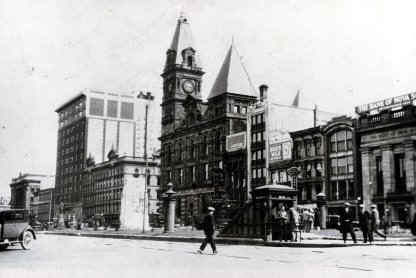 The next change to be implemented in the park, following the erection of the
statue of Sir John A. MacDonald, was public access. At that time, access to the park
remained restricted to a fixed period each day. In May of 1909, the city received an offer
from William Southam, owner of the
The next change to be implemented in the park, following the erection of the
statue of Sir John A. MacDonald, was public access. At that time, access to the park
remained restricted to a fixed period each day. In May of 1909, the city received an offer
from William Southam, owner of the
For the City’s premature but nevertheless enthusiastic Centennial celebration, tens of thousands of coloured lights festooned the trees in the Gore, Dundurn Park, the Court House Square, City Hall and the Cricket Grounds. This Centennial was in 1913 and was to celebrate the founding of the city 100 years prior by George Hamilton. The Garden Party was given by Stanley Mills at his residence. The entrance fee was fifty years residence in the city. There was a midway complete with trained elephants, boxing kangaroos and performing dogs and horses. There also were girlie shows, side shows, shooting galleries, and refreshment booths. The Centennial’s final event consisted of a pajama parade from the
Waldorf Hotel to Gore Park, for which the city’s leading male citizens donned their gaudiest night attire. Thousands of men lined up for the parade, despite some not being in costume. There was a pajama inspector to separate those who met the criteria from those who did not. To encourage an "entente cordiale", the centennial males carried feather duster "ticklers" to tease the fair sex who reciprocated by wearing headbands inviting "Kiss me, Kid, I’m Kandy".It was during this celebration that the "House Built in a Day" was constructed and Dondidier, the star of the visiting flea circus escaped. He was valued at $500 and special care was taken to try and recapture him. Special detectives and trained dogs were sent out to find the missing flea. It was hoped that the flea would jump on the dogs and return to the attendants running the show. In the end, the returned Dondidier was placed in his cage. His performance for the people of Hamilton included a tango dance and flea stunts.
In 1913, it was proposed that underground lavatories be placed at the corner of Hughson and King Streets, be installed in Gore Park. These lavatories became the subject of considerable debate when all the tenders were found to be too high and Council was forced to draw upon the contingency fund to make up the difference. From February 1913 until the remodelling of the park in the 1980s, the lavatories remained in operation.
As World War I drew to a close in November 1918, great crowds moved to the heart of the city where Mayor Booker declared a holiday – a superfluous formality. Floats, which had been built in the previous weeks for the Victory Loan Parade, turned out again in a mile-long procession that swelled with, decorated cars. On the Gore, Bandmaster Harry Stares’ Band played the National Anthem, "O God Our Help In Ages Past" and "Rule Britannia." Everyone joined in. Twenty-two prisoners were released without sentence by Magistrate George F. Jelfs, and doctors gave prescriptions to all who applied, that everyone might celebrate fittingly. At noon the "Human Fly" climbed the
Bank of Hamilton.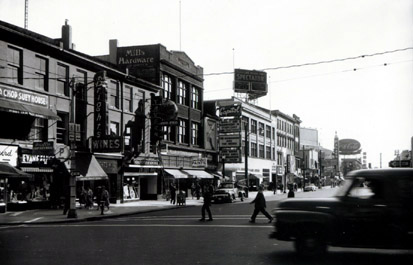 In 1921, the City’s first health
centre was established in the Hamilton Public Library building on the north side of Main
Street West. A combined committee of the Men’s and Women’s Canadian Club
requested permission to erect a cenotaph to honour Hamilton’s war dead. The Cenotaph
was to be located on the site of the "oil derrick" flagpole. The winning design,
declared in August 1921, belonged to W.R. Souter. The Cenotaph was officially unveiled by
the Governor General, Viscount Byng of Vimy, on May 22, 1923. Money for this statue, as
with other structures in the park, was raised solely by private donation.
In 1921, the City’s first health
centre was established in the Hamilton Public Library building on the north side of Main
Street West. A combined committee of the Men’s and Women’s Canadian Club
requested permission to erect a cenotaph to honour Hamilton’s war dead. The Cenotaph
was to be located on the site of the "oil derrick" flagpole. The winning design,
declared in August 1921, belonged to W.R. Souter. The Cenotaph was officially unveiled by
the Governor General, Viscount Byng of Vimy, on May 22, 1923. Money for this statue, as
with other structures in the park, was raised solely by private donation.
In May 1923, the Cenotaph was unveiled in Gore Park. It was erected by the Canadian Club of Hamilton in the memory of the war dead. Robert and Herbert Mills founded the internationally famous
Mill’s China Store in 1927. Just three years later, A.Y. Eaton officially opened the T. Eaton Company Ltd. on James Street North.In the late 1940s, the major problem afflicting the downtown was congestion. The boom which followed the war, unleashed an unprecedented growth and expansion. Both Stelco and Dofasco worked to keep up with the increased demands. Relaxed liquor laws brought new kinds of entertainment to the downtown. Retail giants like Eaton’s, Robinson’s,
the Right House and Eames, were flourishing. Mills China Shop drew customers from distant areas including the United States. Movies theatres in the core faced large lineups nightly and the streets were teeming with people. It was not long before the old City Hall located at James and King William Streets could not accommodate the increased municipal activity. The facilities were simply too small. The freedom created by the use of the automobile produced before unheard of choices and options. On March 31, 1947, the first 325 street meters were installed.The history of Gore Park in the 1950s is characterized by one dominant element – the birds. The Parks Board tried a number of different solutions including letting off cartridges and firecrackers, and banning the feeding of birds in the park. All this was to no avail. In 1952, a committee of the Board of Control recommended trapping the pigeons. Trappers, under the supervision of the Pigeon Elimination Committee, were to receive a lump sum price of $500 for the first 500 birds trapped and destroyed; the next 500 trapped birds sold for $1.20 per bird and each trapper was given an expense budget of $60. This project was soon abandoned when it was pointed out that the committee might accidentally hire "an unscrupulous man who might buy pigeons from a huckster at 40 cents and sell them to the city for a dollar or more." Instead, the city built a loft-type trap at King and Hughson Streets, complete with two females to attract unwary male birds. The decoy birds were stolen, only to be recovered two days later.
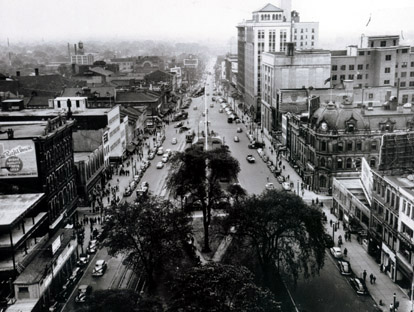 Despite the obstacles and difficulties,
1,200 birds were eventually removed from the park in October. They had been humanely
trapped, with no use of poison or other noxious substances, then shipped to the
"S.P.C.A. gas chamber and painlessly executed." The pigeon population appeared
to be on the decline. The problem then switched from the pigeons to the starling. Attempts
to scare them away with squawk boxes and carved wooden owls were highly unsuccessful. In
1954, extreme measures were taken. In January, 122 hunters armed with shotguns downed
approximately 2,500 birds, In early February, hunters again shot several thousand more
birds. In desperation, the city resorted to feeding the birds grain soaked in whiskey in
the hopes that would become intoxicated and thus be easier to catch and gas.
Unfortunately, as one local reporter noted, the birds "did not topple but flew around
the park; peppily if somewhat erratically. They finally flew to the building tops and
slept it off and did not come back."
Despite the obstacles and difficulties,
1,200 birds were eventually removed from the park in October. They had been humanely
trapped, with no use of poison or other noxious substances, then shipped to the
"S.P.C.A. gas chamber and painlessly executed." The pigeon population appeared
to be on the decline. The problem then switched from the pigeons to the starling. Attempts
to scare them away with squawk boxes and carved wooden owls were highly unsuccessful. In
1954, extreme measures were taken. In January, 122 hunters armed with shotguns downed
approximately 2,500 birds, In early February, hunters again shot several thousand more
birds. In desperation, the city resorted to feeding the birds grain soaked in whiskey in
the hopes that would become intoxicated and thus be easier to catch and gas.
Unfortunately, as one local reporter noted, the birds "did not topple but flew around
the park; peppily if somewhat erratically. They finally flew to the building tops and
slept it off and did not come back."
By 1948, Hamilton’s population had begun the post-war climb, which has continued to the present. As the city increased in size in the post-war years, so too did the amount of crime. As vehicle traffic increased, traffic violations and infractions multiplied. In response, 146 new police officers were recruited to the Hamilton Police Force in 1951. The addition brought the strength of the force up to 356 officers by 1952.
In the early part of the 1950s, King Street was widened, much to the dismay of shop keepers who felt they were losing business space. When the street was complete, a parade was held as a re-opening celebration. A mere five years later, the city was again engaged in changing the road system of Hamilton. On October 28, 1956, Hamilton’s transportation and traffic department, in conjunction with the police department, began a 90-day trial period of a one-way street system, which was intended to ease traffic congestion in downtown. The event took many months of planning and weeks of intense publication advertising changes in traffic patterns. These changes were to occur in the lower and central parts of the city, in the area between Margaret Street in the west and the Delta in the east. This switch was described as "the modern answer to the city traffic problems". After much research, it was felt that the new system would be much safer and would efficiently move traffic at a more rapid pace. "The basis of this new system is the pairing of streets, with traffic moving in opposite directions on parallel streets. The key streets in the system are James and John, and King and Main . . . If you’ve been in the habit of using one of these paired streets to travel across town, you simply continue to use the one you’ve always used in one direction, and take its partner to go the other way." (Spectator, October 1956). Reaction to this one-way system was generally favourable.
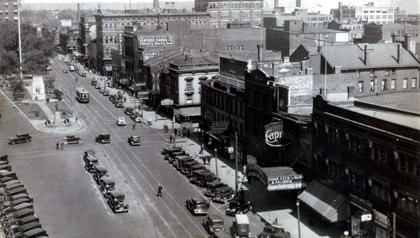 Aside from changes to roadways, the city was
altered in many other ways. In 1953, the
Aside from changes to roadways, the city was
altered in many other ways. In 1953, the
It was during the term of Mayor Lloyd D. Jackson that the new City Hall, County Court House, Art Gallery, Macassa Lodge (a home for the elderly), a much needed sewage treatment plant and Market were built. The call for the relocation of City Hall came in 1959 when the then existing facilities proved simply too small. Of the choices for the location of the new City Hall, Mayor Jackson favoured the Main Street site because it provided a western anchor for the downtown business section, forming a nucleus of administrative buildings with the new federal building. The following year, on November 5, a new four-storey market parking facility was erected at a cost of $1,000,000. It was quite efficient having elevators, automatic ticket dispensers and an electronic instrument panel to make parking easy.
Gore Park also faced change in the 1960s. The
Old Victorian Fountain installed for the Royal visit of 1860, was eventually condemned as unsafe, and removed to make way for three saucer-shaped fountains donated by the Kinsmen Club. A new steel flagpole, donated to the city by Dofasco, was also placed in the park.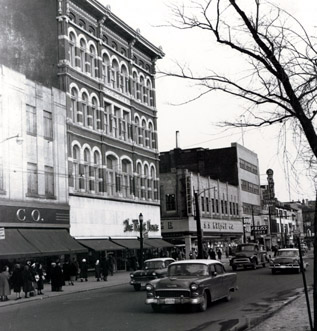 The presence of the Stelco Tower in the
downtown core increased the probability of the future presence of an indoor shopping
centre. Terminal Towers was completed in 1966 and remains Hamilton’s largest downtown
structure. It covers a full city block and the entire complex is valued at $12,000,000. It
houses an eight-storey hotel having 240 rooms, a ten-storey office tower and a 12-storey
apartment tower mounted on a five-storey podium of shops, magistrates, courtrooms and
facilities. There is also indoor parking. The podium roof contains a swimming pool, a
wading pool, patio, pedestrian areas and convention accommodation including a hall to seat
1,000 or to hold a banquet for 500-600 people.
The presence of the Stelco Tower in the
downtown core increased the probability of the future presence of an indoor shopping
centre. Terminal Towers was completed in 1966 and remains Hamilton’s largest downtown
structure. It covers a full city block and the entire complex is valued at $12,000,000. It
houses an eight-storey hotel having 240 rooms, a ten-storey office tower and a 12-storey
apartment tower mounted on a five-storey podium of shops, magistrates, courtrooms and
facilities. There is also indoor parking. The podium roof contains a swimming pool, a
wading pool, patio, pedestrian areas and convention accommodation including a hall to seat
1,000 or to hold a banquet for 500-600 people.
The 1970s were a period of expansion, construction and renewal for the downtown core. On October 19, 1970, the construction of
Jackson Square, which was part of an urban renewal project, began. In 1971 the city tried to close King Street from Catharine to James, to traffic in an attempt to transform the area into a pedestrian only outdoor mall. This only lasted a few weeks. The following year, the building which would house the Football Hall of Fame was completed. The Grand Opening was held on Grey Cup weekend. Hamilton Place opened on September 22, 1973. In 1976, calls for a downtown arena were satisfied. The city undertook building a coliseum, which was located at Bay Street and York Boulevard. This project was added to the Downtown Redevelopment Project. The coliseum is officially named the Victor Kennedy Copps Trade-Centre and Arena. The sod-turning event was held in 1983. Pigott Construction Ltd., was chosen to build the arena. The opening was held on November 30, 1985 with a ceremony at 11:30 a.m. followed by an "old-timers" hockey game at 7:30 p.m.. Five thousand free tickets were made available for those who wanted to attend the game.The new Art Gallery of Hamilton opened on October 1, 1977 and was described by Anne Jones, regional chairman, as a light that "shone through the dullness of the day like a jewel in the middle of Hamilton." The total cost of the new building was estimated at $5,300,000. The Gallery has an extensive collection of contemporary Canadian Art. Hamilton now had the important elements of a successful city: Concert hall, modern library, meeting places, four star hotel, and art gallery.
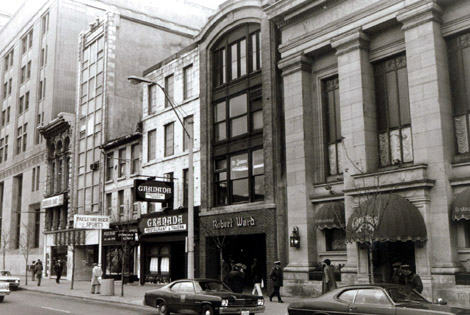 The early part of the 1980 was a period of
considerable controversy for Gore Park redevelopment. In 1983, as part of a renewal
project, the old trees that had long stood in the Park were cut down. This event came to
be known as "the Gore Park Chain Saw Massacre" which was part of the "Gore
Park Blunder". The City faced extreme outcries from citizens. It was felt by all that
the trees should not have been cut down. More cries were heard when the city attempted to
erect two cement block buildings in the park. Renovations to the park and the adjoining
railway were completed in November 1984 at a cost of $2,500,00 and great public dismay.
The early part of the 1980 was a period of
considerable controversy for Gore Park redevelopment. In 1983, as part of a renewal
project, the old trees that had long stood in the Park were cut down. This event came to
be known as "the Gore Park Chain Saw Massacre" which was part of the "Gore
Park Blunder". The City faced extreme outcries from citizens. It was felt by all that
the trees should not have been cut down. More cries were heard when the city attempted to
erect two cement block buildings in the park. Renovations to the park and the adjoining
railway were completed in November 1984 at a cost of $2,500,00 and great public dismay.
There were many factors affecting the decline in downtown’s popularity and appearance. Some of these included thousands of layoffs, aging stores with absentee landlords, the recent bus strike, parking, and raising taxes. In 1982, it was thought that a population increase might aid in the revitalization of the core. Copps Coliseum was built to increase the flow of people in the downtown. Owners of stores located in the core noticed that when the coliseum opened, business increased. The arena brought people to the centre of the city.
Jackson Square shopping centre was the main business that reaped the benefits. The business of restaurants and other establishments increased greatly when events were held at the arena. A strategy was developed which included proposals such as working with landlords and businesses increase the number of American retailers, provide facilities for design studios, software firms and "loft" apartments, works with transit to increase access to the core and making King Street a 2-way street. In 1989, there was a major fire between John and Catharine Streets, which destroyed buildings at the west end of the block. Bright’s Wines and the Mayfair restaurant were destroyed.The 1990s have proven to be a period of deterioration for downtown Hamilton. In 1990, a building boom was planned for the core. Buildings were demolished so that new buildings and businesses could move into the area. Statistics from 1994 indicate that the population of downtown residents was approximately 26,000 people. Of these, 55 per cent were single people and more than 70 per cent of all downtown residents were renters.
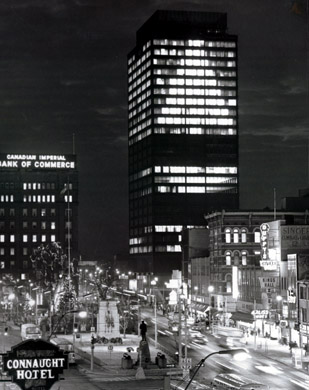 In an attempt to lure people and commerce to the downtown area, the
Hamilton Parking Authority on July 18, 1996 decided to offer free parking at all but five
municipal parking lots downtown on Thursday and Friday evenings, all day Saturday and
Saturday night. This was first done on a temporary basis over a three-month trial period.
It was believed that this would improve the ability of downtown merchants to compete with
retailers located in shopping malls where parking is both free and abundant.
In an attempt to lure people and commerce to the downtown area, the
Hamilton Parking Authority on July 18, 1996 decided to offer free parking at all but five
municipal parking lots downtown on Thursday and Friday evenings, all day Saturday and
Saturday night. This was first done on a temporary basis over a three-month trial period.
It was believed that this would improve the ability of downtown merchants to compete with
retailers located in shopping malls where parking is both free and abundant.
On June 21 and 22, 1996, over 120 volunteers came together in downtown Hamilton, as part of the Downtown Hamilton Ideas Charrette, a type of brainstorming session whose objective was to discover why the downtown was dying and to develop a series of recommendations for revival. Hundreds of ideas were generated and a general agreement was reached. The problems facing the core were rooted in such issues as parking, taxes and traffic. Another issue raised, concerned the one-way road system of the downtown.
The one-way streets allow vehicles to travel quickly through the city and accommodate large volumes of traffic. The result however, is that large volumes of traffic are routed right through the heart of the downtown. Also, access to many businesses is impeded by the one-way flow, especially for those who are new to the area and unfamiliar with the one-way system. The recommendations made were then passed on to both the city and region councils for study and action.
In 1997, many attempts at revitalization and regeneration occurred. The former
Woolworth building on King Street East was given a $1,500,000 renovation which it was thought, would generate more pedestrian traffic along King Street East, from civil servants to shoppers to job seekers. In June, a $2,500,000 initial phase began on the "Restore the Core" project which was intended to give the core a distinctive facelift. The total budget available to the project was an estimated $8,200,000. That summer, there was talk of banning loiterers who were constantly occupying the street and the Park, begging for money. A bylaw, aimed at stopping panhandling and loitering was passed. The Pigott building was transformed into condominiums. There was even talk of creating a charity casino.In 1997, a facade improvement program was launched for the Gore area. In addition, the Core Heritage 2000 Program, whose aim is the improvement and revitalization of the City’s central historic core area, is being implemented. The buildings are to be restored and storefronts enhanced in accordance with the vision established in the "Gore Heritage Design Study", approved by City council in 1996. The project is seeking to evaluate the physical and visual qualities of the buildings within the downtown core and recommend strategies for renovations and improvements to signage, to storefronts and to building facades.
On April 14, 1998, the adoption of the Downtown Hamilton Business Improvement
Area’s Community Improvement Plan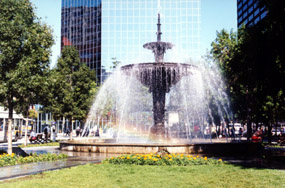 for the
expanded area of downtown was implemented. By the summer of 1998, $850,000 had been set
aside for loans and grants, to be used as part of four programs that commercial
proprietors could tap into to aid in the improvement of their properties. With the
additional infusion of capital that year, these programs had a total of approximately
$2,000,000 available for downtown renewal.
for the
expanded area of downtown was implemented. By the summer of 1998, $850,000 had been set
aside for loans and grants, to be used as part of four programs that commercial
proprietors could tap into to aid in the improvement of their properties. With the
additional infusion of capital that year, these programs had a total of approximately
$2,000,000 available for downtown renewal.
In August 1998, a special committee of municipal politicians was established to decide which of two development firms should receive the go ahead to built a multi-million dollar entertainment centre in downtown Hamilton.
The City of Hamilton has gone through many and varied changes since its early days as a mere settlement. It is evident that the area comprising the downtown has always been and will continue to be of great civic, cultural and historical importance to the people of Hamilton. It is here that the heart of the City is found.
REFERENCES: